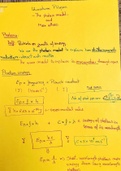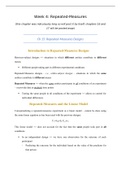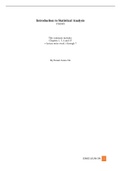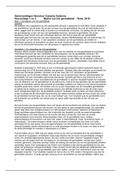Topic 1: A relational and contesting view of Planning
1. Introduction to course & A relational view of Planning
Reading
Salet, W. (2014) ‘The Authenticity of Spatial Planning Knowledge’. European planning studies, 2014, Vol.22 (2),
p. 293-305
The Embedding of Spatial Planning Studies in Practice
Spatial planning was generated in the industrializing epoch of the late nineteenth century by civic organisations
rather than by governmental intervention. Nowadays, spatial planning studies seek to improve “collective action as a
form of spatial intervention” in legitimate and effective ways. This mission involves all sorts of private- or public-sector
initiatives, and manifold combinations. Spatial planning is a theory of spatial interventions.
Association of European Schools of Planning (AESOP, 1995) represents the schools of planning in Europe: it is not
an association of planning practitioners, yet it defines its study object as a form of collective action directly related to
practice. The “spatial planning intervention” is context-bound, it is dedicated to the normative aim of a better future
of spatial organization, and it mobilizes knowledge and action towards a new stage of spatial organization. In some
experimental corners of the field, researchers do aim to intervene in practice themselves by way of experimentation
and learning but in these cases, obviously, it is even more important not to mix together the different positions of the
scientific researcher and the practitioner of planning (Straatemeier et al., 2008) because the scientific position requires
a critical distance to be taken from the interests of planning authorities and other participants involved in the planning
process. The rationale of the scientific planning discipline is to search for ways of improving the legitimate and effective
ways of practices of spatial planning. In doing so, both planning education and research must critically investigate
existing practices and the findings must make sense in new practices.
Researchers keep separate roles; still they often employ their work in networks of mutual learning and in close
contact with practitioners. Also, the education at planning schools often involves practitioners. A notable illustration
of using the format of practical learning via the introduction of “studios” in the curriculum of planning studies is
presented by the so-called higher education in spatial planning network coordinated by Bernd Scholl at ETH Zurich
(http:// www.hesp.ethz.ch). The valorisation and the dissemination of the research outcomes are institutionalized in
the normative framework of relevance in practices. At the same time, but according to “completely different methods,
customs and norms of accountability”, the research outcomes have to be valorised in the scientific domain.
What Planning Studies Learn as a Science of Practice
The first and most important lesson of observing practical experiences of planning is to respect the condition of
complexity and to recognize the high uncertainty of what planners actually do know about the object of intervention
and about the impact of deliberately organized collective action in the real world. Social reality is not only hard to
grasp for planners in practice, it should also make scientists more modest about the ways to deal with such practical
phenomena as “uncertainty, social complexity” and “ambiguity of norms”. The science of action planning knowledge
has learned in the hard way that it should not reduce or neglect the elusive aspects of reality and that it cannot aim
for certainty of knowledge. It has learned that its purpose is to search for ways of dealing with unknown and
uncontrolled conditions and with different rationalities.
There is a wide tradition of scholarly work on the invention of new theoretical insights in practices, symbolized in
such emblematic titles as “the practitioner as theorist”, the “reflective practitioner”, the “deliberative practitioner”,
etc. Learning from practical experience is a well-established attitude in spatial planning sciences. Actually, the
increasing awareness of planners about what they do not know and the certainty that progresses in planning processes
most probably will work out “differently” than expected at the outset is one of the most important sources of
inspiration to search for new strategies which might better enable to intelligently deal with the harsh and irrational
conditions.
Some of the specific insights on planning theories which follow from their direct interrelatedness with practical
experience:
, • In conceptual terms, this planning is "active reconstruction" and "reshaping" rather than "free
construction" or "free design". It is highly "context-bound" and elaborates on the normative patterns of
"institutions"
• Planning is a normative engagement to achieve a better spatial future. It deals with values and with social
and political objectives, which differ in various backgrounds and rationalities, and with issues of social and
spatial transformation. All this conceptual stuff is “normative”, highly “poly-interpretative” and conflictive
• What planning theory has learned—since the 1960s onwards—is that planning trajectories have to respect
the notions of “adaptability”, “flexibility” and “resilience” of policy choices
• It is not only systematized cognitive knowledge which matters but also planning knowledge which has
other layers such as “reflection”, “experience”, “emotions” and “political rationality”. It is often observed
that the practical relevance of cognitive knowledge is rather modest in social processes of planning. For
this reason, planning sciences should be aware of investigating the impact of different sources and
rationalities of planning knowledge
• A final lesson is that planners have learned to deal with planning processes as dedicated but open-minded
and open-ended processes and that planning processes explicitly should be organized as processes of
“learning”
The examples intend to illustrate the emergence of theoretical concepts, brought forward by the direct interaction
of scientific researchers with networks in practice and by observation of planning and collective action experiences in
practice. It is a way of thinking and searching through which the planning discipline—as a science of contextualized
norms, knowledge and action (rather than solely systematized cognition)—strongly differs from purely explanatory
scientific disciplines.
The Authentic Object of Planning Studies
Planning theory leans in many respects on the insights of mother disciplines and adjoining disciplines; it is highly
“interdisciplinary” as is well demonstrated in the readers on planning theory. Despite many cross-pollinations on parts
of the scientific object no other scientific discipline shares the complete interrelated set of the following five
dimensions and no other discipline tends to integrate these dimensions in coherent paradigms! The ways in which the
five dimensions may be integrated defines an authentic conceptual frame for spatial planning studies. The following
dimensions are distinguished:
The single dimensions, as such, are not exclusive for spatial planning studies, and all dimensions of the planning
object—even the normative dimensions or the emotional or interpretative forms of knowledge—may be investigated
via established and regular scientific methods. The interdisciplinary nature of planning studies creates a fertile ground
for the cross-fertilization of scientific disciplines. There is a lot of inspiration from other disciplines, such as urban
design (heuristic, solution focused and grounding on generative mechanisms) or political sciences with regard to the
normative dimension; geography or urban economics with regard to aspects of cognitive knowledge; and management
studies, finances or law with regard to the dimension of action. However, what gives spatial planning its authentic and
exclusive object—in the sense that spatial planning studies is the only scientific field where you may find this particular
dedication—is the challenge to grasp the five dimensions in “conceptual coherence”. In this article, it is claimed that
a specific planning theory can be complete only if it conceptualizes the interrelationships between the five
aforementioned dimensions according to its own assumptions.
We demonstrate the characteristic differences of spatial planning paradigms from the different angular points of
Figure 1 as follows:
, (1) Mobilising planning via the “normative sense of spatial direction”: the normative ideas about a better spatial
organization for the future are taken as a lead to knowledge and action and change of context. The stage of
the “theatre of the future” is actively set with promising frames or policy discourses. The normative senses of
direction are leading for the ways in which knowledge, action and context are identified and mobilized in order
to pave the pathways to a better spatial future. Planning theory has a lot of relevant conceptions, reflections
and applications of empirical research which may underpin the significance of this proactive and mobilizing
approach of planning.
(2) The structuring power of the “action dimension”: here, planning researchers do not believe in the mobilizing
role of normative interpretation and setting up policy discourses. Instead, the focus is on the ways in which
the resources of action are coordinated and organized in powerful structures of resources or alliances of action
and defining from this position of power the margins of planning knowledge that comes true. So, action does
not follow the normative senses and the interpretation of the world, but precisely turned upside down the
interpretation follows the ways in which action and power are organized.
(3) The conditioning role of “existing planning context”: These spatial planning researchers claim that the
normative senses of direction, the knowledge and the action dimension of planning, essentially are
contextualized in social driving forces. Principal adherents claim that the way in which planners think, know
and act is, essentially, dependent on their position in society. One may recognize here the theoretical
assumptions of the “sociology of knowledge” paradigm. We only have to memorize the prolific work of
Friedmann (1973, 1987), elaborating on the principia media of Mannheim (1985) [1935]. In epistemological
terms, Mannheim labelled his position as the “perspectivism” or “relationism” of knowledge and action,
indicating that the validity of knowledge and action is related to the specific position of the knower (or the
actor) in the surrounding context (social structure). Mannheim argued that social processes may get a different
meaning when they are considered from different points of view (depending on the position of the viewer or
actor in society).
(4) Probing the consequences of planning in new context of practice: The pragmatist view points out that the
contextualized senses of direction, knowledge and action have to get real meaning by experimentation in
practice. We have to consider what comes out of the planning intervention, if we want to discover which
norms, knowledge and action strategies are valid. In epistemological terms, this position of knowledge and
action is known as “consequentialism”: Pragmatism is not as much interested in the causes of social processes
but in the consequences. Only the outcomes reveal what the real meaning of planning intervention is. In case
something else comes out of it than expected, one should try a different solution (trial and error planning).
Thus, the field of planning knowledge is marked from coherent paradigms starting at the four different polar
angular points. Most planning theories are somewhere in between, combining different parts of assumptions and thus
bringing forward different meanings and methodologies of research. What the different models have in common is
that they represent the authentic essence of spatial planning knowledge. Planning theory poses its own
epistemological conceptualizations by combining the true meaning of knowledge in different ways with normative
positions and actions, all closely related to practical context. In this way, the discipline develops unique and very
characteristic dilemmas in the meta-theoretical debate.
The Need of Double Valorisation of Planning Knowledge
Planning studies face the need of double valorisation: via the regular accountabilities of the scientific world and
also by those of the professional practices. This is quite challenging as the two ways of valorisation are extremely
different. It requires that the same output of research has to be valorised and disseminated according to completely
different traditions and rationalities, different languages and different platforms of dissemination. Practical validation
of planning knowledge is usually contextually based on networks of cooperation with professional practices and
requires specific language. Scientific research, in contrary, is validated internationally and interdisciplinary.
Sometimes, the requirements of scientific validation are criticized as being biased to particular scientific cultures and
as being selective to anglicized (in particular North American) dominancy. There is a lot of debate on biases of scientific
indicators, such as International Science Information citation indexesz. The methods of scientific accountability are
not tailor-made to the specific characteristics of practice-rooted planning studies. However, this also goes for various
other disciplines with their own peculiar characteristics. Sometimes, it is argued that planning studies should define
own disciplinary norms of combined practical and scientific accountability. Running your own competition does not
make sense in the multi-disciplinary world of science. So, there is no alternative for taking the double routes of
validation. Spatial planning studies do not need the defensive arguments, as long as these studies manage to capitalize
on the authentic essence of planning knowledge and experience via probing and testing in practices. Spatial planning
studies never should get rid of the practice-oriented mission. The nature of planning knowledge is rooted in practical
experiences but, simultaneously, researchers must bring this on the highest platforms of scientific validation.
The Dynamic Position of Spatial Planning Studies
, We observe two rather paradoxical tendencies in the current stage of transition: a reduction of scope and at the
same time the enlargement of scope of local schools. Reduction of scope becomes manifest in the framing of
specialized master courses and additional postgraduate courses with fashionable profiles in order to attract new
markets. The familiar label “urban and regional planning” or “spatial planning” is not always visible (not even in master
courses in planning schools): it may have been changed to “urban management”, “urban design”, “urban
development”, “environmental policies”, “urban governance”, etc. Simultaneously, there is a tendency to widen the
scope of planning schools in larger formations. Because the scale of the planning discipline is too small at most
universities, the planning discipline amalgamates with adjoining disciplines. Due to the interdisciplinary relationships,
the position and the behaviour of the spatial planning studies can look like a chameleon type of adaptation. Even
within the setting of one country, it may merge with completely different scientific disciplines at different universities.
In The Netherlands, for example, the six schools of spatial planning have merged with different disciplines (such as
Policy Sciences in Nijmegen, Geo-Sciences in Utrecht, Technical Sciences in Delft and Social and Behavioural Sciences
in Amsterdam).
Spatial planning studies has never been a type of mono-culture; rather, it is a discipline with an interdisciplinary
signature. This volatile condition offers excellent opportunities to select new enriching combinations and to adapt if
better opportunities are available. On the other hand, there are also risks and threats, of course; in particular, of losing
the autonomy of the planning discipline in both processes of rescaling. Small schools are likely to be in a more
dependent position than well-institutionalized schools and disciplines. Not every school is able to make its own
choices. So, the strength, weakness, opportunity, threat profiles differ strongly for the large variety of local schools.
The dynamic context of planning schools creates a high changeability of external conditions with a severe impact on
daily practices of teaching and research in this stage of radical transformation. The requirements for accreditation and
valorisation will have to adapt accordingly.
The best remedy for the increasing uncertainty about the external position of planning studies seems to be to
invest in the authentic object of planning knowledge and from this self-confident position to keep an open and flexible
mind for opportunities of enrichment via external alliances. This planning knowledge has to be valorised at a high
scientific level which enables open contacts in larger academic configurations.
Conclusions
It has taught students of planning to recognize and to deal with the elusiveness and multi-interpretive features of
social reality and instead of solely relying on presumed certainties of cognitive knowledge to search for strategies to
deal fundamentally with complexity and uncertainty. The interdisciplinary nature of spatial planning leans on the
insights of various adjoining disciplines (such as spatial and design studies and various disciplines on social, economic
and political action) but, typically, spatial planning theory only will make real progress when new thoughts, insights
and findings are focused on its own authentic and coherent object of study. The authentic object of study is identified
and explained as the coherent interconnectedness between context-bound senses of spatial direction, knowledge and
action, which is to come validated by new practices of social interaction.
Characteristic for spatial planning studies is its need of double valorisation: both in practice and in science. The
two ways of valorisation (in practice and in science) differ strongly but may also strengthen each another. It is
concluded that there is no alternative for the basic requirement of double valorisation. This conclusion is underscored
by the dynamic processes of rescaling in the actual context of academic governance which is resulting in many mergers
and new forms of alliance of scientific disciplines.
Lecture
What do planners do when they do ‘spatial interventions’?
The development is way more erratic than we expect. How do we deal with that?
Cities are complex, we do not always know how they work. What we know is
− A collective process
− More or less organized
− More or less conflictual
− Oriented to a future state of the environment (built, social, economic or natural)











